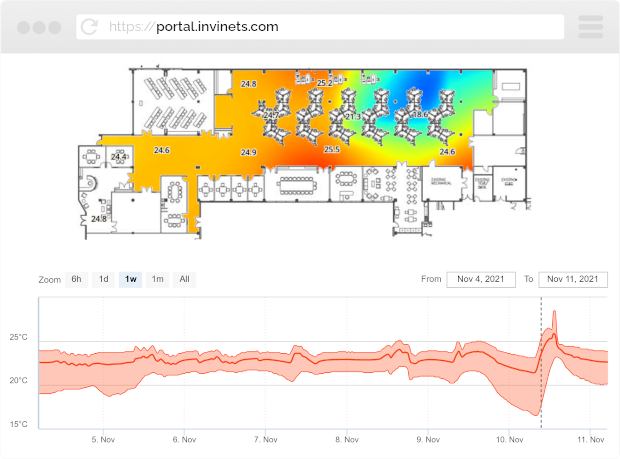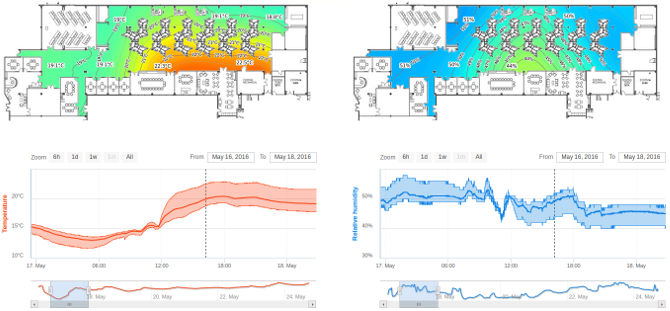
see temperature in the browser
History, alerts, reports, humidity,calibration, CSV download, movies.
ThermoMesh is a feature complete turnkey solution.
The ThermoMesh system is an innovative and proven platform for monitoring and managing temperature and humidity online. It is used in a wide range of industries and facilities, such as: undercover crops, warehouses, cold stores, production lines, logistics centers, data centers, laboratories, hospitals, museums, libraries and archives.

The ThermoMesh system allows you to reduce costs and increase quality by:
Call or e-mail us, so that we can help customize a sensor set to your needs.
Send us a map of the room in which you want to place your sensors, and we will beautify and upload it into the portal, so that it is ready when you receive your sensor set. You can also add the map by yourself.
The magnets in the sensor casing and the lack of any cables make the installation process fast and painless.
In the simplest configuration, the gateway sends the sensor readings to our portal via a GSM modem. As stated above, other configurations are also possible.
Our portal features an extremely simple method of sensor placement. Just drag'n'drop the sensor icons from the box in the portal onto the room plan.

The system's functionalities work very well in managing costs reduction and quality increase in crops under cover. The system allows: analysis and management of even temperature and humidity distribution, saving energy costs by maintaining temperature limits in the coldest places, preventing the development of diseases and other factors limiting the efficiency of production, creating long-term maps of fungi and mold growth threats. The functionality of generating alarm notifications (SMS, e-mail) in the event of exceeding the user-defined limit range is very useful.

Easy installation and high scalability of the ThermoMesh System very well meet the needs of the logistics industry and the industry of warehouse space developers. The main area of use is monitoring of environmental conditions in time and space. Particularly valuable functionality is the high quality of temperature and humidity maps, which allows quick identification of the place and source of irregularities. It is very important to be able to store data and generate analytical reports and reports required by contractors, legal environment as well as quality management systems.

The innovativeness and comprehensiveness of the ThermoMesh System combined with 24/7 online availability in any place meets the requirements of protecting valuable collections and objects stored in museums, archives and libraries very well. Thanks to the flexibility and precision of the ThermoMesh System, you can accurately determine the micro-climatic conditions at individual points of spatial objects, and then monitor them online. ThermoMesh allows you to precisely define the boundary parameters of the storage environment and generate alert notifications (SMS, e-mail) in case of exceeding them.

The innovation and high scalability of the ThermoMesh System very well meets the needs of the meat and poultry industry. The main areas of use are monitoring the conditions of meat storage environment and meat products as well as monitoring the storage environment for production means e.g. packaging. Particularly valuable functionality is the high quality of temperature and humidity maps. It allows quick identification of the place and source of irregularities. It is very important to be able to store data and generate analytical reports and reports required by contractors, legal environment as well as quality management systems.

The innovativeness, comprehensiveness and scalability of the ThermoMesh System very well meets the needs of the woodworking and packaging industries. Particularly valuable functionalities of the ThermoMesh System are high quality temperature and humidity maps as well as an effective alarm notification system by e-mail and SMS. In addition, the system allows you to create a wide range of analyzes and reports for the needs of contractors. Easy installation and relocation of sensors is very important - it gives the possibility of precise adaptation to monitored objects and processes.

The innovation, flexibility and comprehensiveness of the ThermoMesh System combined with 24/7 online availability very well meets the requirements of institutions for which the key is to ensure the quality and reliability of laboratory and scientific research. The use of the ThermoMesh System solves the problem of continuous monitoring of the storage environment of drugs, vaccines, samples, reference materials and reference materials. In addition, the system provides long-term storage and multidimensional analysis of collected data. The functionality of generating alarm notifications (SMS, e-mail) in case of exceeding the user-defined range is very useful.
The portal allows conducting a wide range of analyzes aimed at identifying factors and mechanisms leading to cost reduction and increase in the quality of processes carried out in monitored facilities.
In addition, it is a very flexible platform for defining and implementing any practically any type of report, such as: periodic, final, for audits, required by contractors or legal regulations, ad hoc reports, etc.


The portal generates a temperature and humidity map for every fixed interval of sensor readings. To view the map from a given interval, you just need to point it in the time plot. The frequency of generating maps is configurable by a user and may range from 5 seconds to 1 hour.

The portal allows for configuring alarms that send an e-mail or SMS notification whenever an environmental parameter exceeds a threshold. For instance, it is possible to set an alarm that is triggered when the maximal inlet humidity for a selected group of servers exceeds 40%. An average alarm trigger time is 1 minute.

Data is collected independently for each room (rooms, halls, cold rooms) that is monitored. To create a new room, all you need is a graphic with its plan. Then, simply drag the sensor icons onto the plan to reflect their placement.

The portal allows for tracking the battery state of all deployed sensor nodes. Thanks to this functionality, you will know precisely when it is time to replace their batteries.
The main component of ThermoMesh is wireless sensor nodes. They feature an embedded microcontroller, temperature and humidity sensors, a low-power radio and batteries. In effect, they can precisely monitor the environmental conditions in a room without the need for installing an additional infrastructure.


Factory-calibrated temperature and humidity sensors ensure a high measurement precision. Thermometer readings do not exhibit errors of more than 0.25°C on average; hygrometer readings do not drift by more than 3% of relative humidity (see the calibration certificate in Polish). The period between successive readings is one minute.

Each sensor node is powered by a pair of common and inexpensive AA batteries; their replacement is simple (no screws in the sensor casings). In addition, each node can be plugged to a USB port, which allows for powering the node from a mobile phone or a computer.

A node has built-in magnets that enable attaching it to steel surfaces. Mind that these magnets have been customized specifically not to interfere with electrical appliances. Moreover, a sensor casing allows for mounting by means of zip ties or common screws.

In open spaces with line-of-sight visibility, the range of the node radios is approximately 200 m. Indoors, the range is comparable to that of a high-end WiFi router, often outperforming it. The radio signal covers rooms, long corridors and typically two or more adjacent storeys.

The radios of the sensor nodes are configured to utilize as their communication channels those parts of the 2.4 GHz band that are unused by WiFi. In effect, sensor nodes and regular WiFi gateways do not interfere with each other.

The radio hardware of sensor nodes is compliant with the IEEE 802.15.4 physical-layer communication standard. On top of that, we have implemented the 6LoWPAN protocol suite, which facilitates communication based on the IPv6 protocol, a foundation for the Internet of Things vision, and higher-layer protocols, such as UDP. Connecting sensors to the Internet has never been easier!
In ThermoMesh, a gateway acts as an Internet gateway for the sensor nodes. Equipped with a radio, it receives packets from the nodes. Subsequently, it transmits such packets further in one of the following ways. First, it can forward the packets to our portal in the cloud, which is the simplest option. Second, it can forward the packets to a building management system (BMS). Third, it can make the readings in the packets available through the popular SNMP protocol.


By default, a gateway forwards sensor readings to our cloud-hosted portal through an encrypted private channel. As a result, no software has to be installed locally to make the sensor network operational. Just visit the portal's website to view the collected data.

In places where Ethernet is available, it is sufficient to plug an Ethernet cable to a gateway. The gateway will automatically configure a connection to the Internet via DHCP. In places without Ethernet, it is possible to plug a GSM modem to the gateway. In either case, the sensor data is sent by sensors to the gateway and by the gateway to the portal via an encrypted private channel.

Deploying multiple gateways at various spots of a room improves the reliability of the network and allows for collecting data from a larger area.

ThermoMesh is a highly customizable solution. A gateway can forward packets with sensor readings to an arbitrarily configured IP address and UDP port. The receiver can, for instance, be our mini-server (under an open source license), which makes the readings available for external systems via the popular SNMP.

A gateway has no software limit on the number of supported sensor nodes. The theoretical hardware limit, in turn, stems from the maximal radio throughput and is approximately 6000 sensor nodes. In practice, a single gateway can easily forward packets from a few hundreds of nodes.

A gateway is powered via a normal AC power plug. It can be used anywhere where usual electrical sockets are available.
Contact us.
Satisfied customers are the most precious resource of
our company. Our experts will gladly answer your questions.
They will advise on the best course of action towards
improving the efficiency of your organization.
We will respond to your query in two business days.
